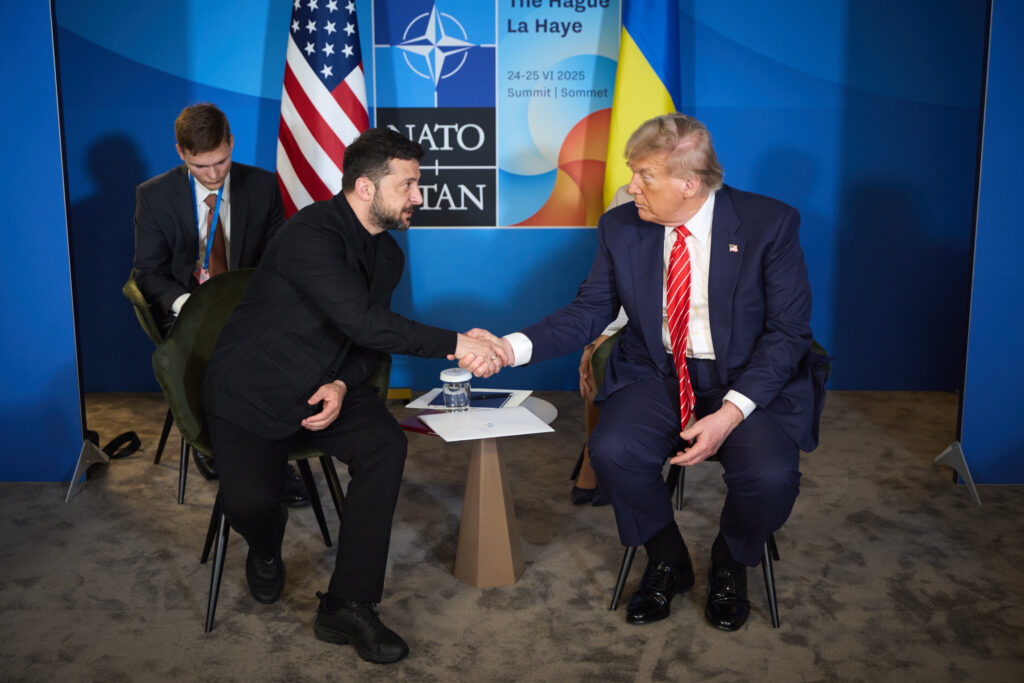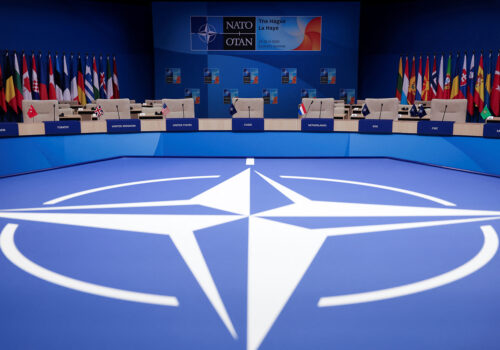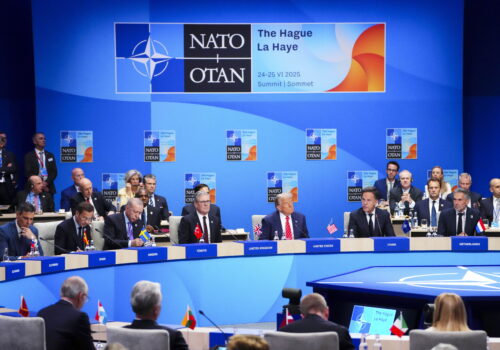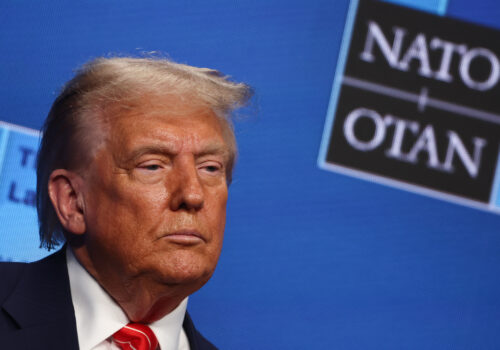This is part of a series of regular assessments of the efforts, spearheaded by the Trump administration, to achieve a negotiated end to Russia’s war on Ukraine. Read the previous edition here.
US President Donald Trump’s policy toward Russia’s war on Ukraine continues to evolve in a rush of small and large steps as he reacts to events in Europe and beyond. The two large recent occasions for this were, first, the Israeli-US strikes against Iran’s nuclear program and, second, the NATO Summit at The Hague. While there were contradictory signs, Trump’s reaction to both major events signaled an evolution toward a tougher line on Moscow.
Since he won the election last November, Trump promised that he would end the Russian war on Ukraine by asking for concessions from both sides and putting pressure on the side obstructing progress toward a durable peace. Since March, Ukraine has accepted without quibble several of Trump’s proposals while Russia has first deflected, then rejected them. Despite this, the Trump administration has been reluctant to put pressure on Moscow. Washington underscored this at the June 16-17 Group of Seven (G7) summit, when Trump blocked an initiative to lower the price cap for a barrel of Russian oil from sixty dollars to forty-five dollars, which would have put more pressure on the Russian oil revenues enabling its aggression in Ukraine. Trump provided a second gift to Russian President Vladimir Putin at that summit by criticizing his G7 colleagues for expelling Russia from the Group of Eight (G8) after Moscow seized and “annexed” Crimea in 2014.
The Middle East dimension
On June 13, a few days before the G7 summit started, Israel began its remarkably successful operation against Iran’s nuclear program and military capabilities. Trump used the Middle East conflict as a reason to leave the G7 summit early, expressed his long-held view that Iran must never obtain nuclear weapons, stressed support for Israel’s operation and, with US allies, provided additional air defense for Israel. Trump then ordered the June 22 strike on Iran’s nuclear facilities at Fordow, Isfahan, and Natanz.
An immediate, albeit inadvertent, impact of the Middle East escalation on the war in Ukraine was a shift of Western political and media attention away from the Kremlin’s rejection of Trump’s peace proposals and its savage bombing of Ukraine. More tangibly, it also resulted in the movement of scarce air defense systems to Israel and US military positions in the Middle East. Further, the war in the Middle East likewise persuaded US Senator Lindsey Graham not to introduce a revised version of a tough Russia sanctions bill. The current draft, with eighty-four Senate cosponsors, would place 500 percent tariffs on all nations purchasing Russian oil. Graham said last week that “Iran is center stage,” leading to the Russia bill’s delay, but he added that the Senate would move on sanctions “sooner rather than later.”
Work on that bill began more than two months ago as a response to the reluctance of the White House to put additional pressure on the Kremlin. It is striking that even as the administration continued to make friendly gestures to the Kremlin—blocking the G7 price cap on Russian oil and trying to minimize the references to Ukraine in the final statements at the G7 and NATO summits—Senate Republicans put on hold the bill that would have exerted pressure on Moscow.
But perhaps the more important development concerns the national security divisions among some of Trump’s core supporters as a result of his policy toward Iran. “Make America Great Again” stalwarts such as right-wing political commentator Tucker Carlson, US Representative Marjorie Taylor Greene, and former Trump adviser Steve Bannon claimed that Trump’s strike on Iran was not consistent with an “America first” foreign policy. Trump dealt quite sharply with Carlson’s criticism, noting that he, Trump, determines what “America first” means. There are also reports that even some senior national security officials, specifically Director of National Intelligence Tulsi Gabbard and Secretary of Defense Pete Hegseth, who are not believed to be in favor of the US military entering the Middle East fray, have been sidelined in administration deliberations.
Whether Trump’s decisive action in the Middle East will extend to the war in Europe is an open question. But the weakened position of the most cautious foreign policy voices in Trump world makes it easier for the president to deliver on his promise of taking the steps necessary to achieve a durable peace in Ukraine. More immediately, that means putting more pressure on Putin. (The most timid faction in Trump world has been partly mollified by Trump’s quick movement toward a cease-fire between Israel and Iran, but it understands that his commitment to a nonnuclear Iran keeps open the possibility of future US military engagement.)
Movement in both directions at The Hague
In the run-up to the summit, the administration’s unwillingness to increase pressure on—or even to criticize—Russia was visible. At the summit last year in Washington, NATO decided it needed a new strategic policy to address the dangers Moscow’s revisionist policy poses. Many NATO leaders believe, along with Ukrainian President Volodymyr Zelenskyy, that a Putin win in Ukraine could be followed by severe provocations and worse against NATO members. But to avoid setting off the US president, NATO decided months ago to shelve the effort to write a new approach. For the same reason, the Alliance also decided to limit the role of the Ukrainian president to side events.
But the outcome of the summit was quite different, and that would not have been possible without Trump’s leadership and approval. Critics of the administration have pointed to numerous statements by the president questioning the need for US leadership in NATO. But these same critics often overlook the broader implications of Trump’s long-running insistence that US NATO allies up their defense spending, which has been a US objective since at least the Reagan administration. At the NATO Summit, nearly all member states agreed to increase allies’ defense and defense-related spending to 5 percent of gross domestic product by 2035—a signature triumph for Trump and for the Alliance. Dmitri Peskov, Putin’s press spokesman, slammed this as dangerous and claimed that it required the West to “conjure up a demonic threat.” It is important, too, that the summit communiqué linked this increase to the Russian threat to NATO. In effect, this achieved a similar result to what the scuttled strategic review of policy toward Russia would have. Moscow was also not pleased by the communiqué’s clear reaffirmation of Article 5—the commitment of each NATO member to the defense of its allies.
Regarding Ukraine, the NATO communiqué stipulated that the allies’ defense contributions to Kyiv count toward their defense spending requirements. That was a tangible sign of support for Ukraine. Trump also made clear both at The Hague and before the summit that Putin was the obstacle to peace in Ukraine. In a recent phone call with the US president, Putin offered to help negotiate an end to the conflict between Israel and Iran. Three times Trump noted publicly that he declined the offer and suggested that Putin pay more attention to ending the war in Ukraine. Trump also said during his visit to The Hague that he would see if he could find additional air defense systems for Ukraine and that he had a good meeting with Zelenskyy.
All these developments over the past two weeks position the administration in the right direction to block Russian designs on Ukraine and, beyond that, US NATO allies. But they do not guarantee the future steps needed to achieve a durable peace and to persuade Moscow to abandon its dreams of empire. US Secretary of State Marco Rubio provided a reminder of this in an interview from The Hague just before the NATO Summit began. He claimed that now was not the time to put down new sanctions because it would persuade the Kremlin not to engage in peace talks. That analysis is simply wrong. Moreover, it is out of step with the numerous statements from Trump that he would put pressure on the party obstructing peace. Even so, Rubio’s comments must be taken as a marker that the administration remains reluctant to press the Kremlin.
What does this all mean? It was a good week for US foreign policy, but still not a decisive one.
John E. Herbst is the senior director of the Atlantic Council’s Eurasia Center and a former US ambassador to Ukraine.
Further reading
Mon, Jun 23, 2025
Expect NATO’s new spending pledge to be overshadowed by weakening US commitment and inaction on Ukraine
New Atlanticist By Ian Brzezinski, Ryan Arick
The Hague summit will ultimately be defined by what the US president communicates about his commitment to transatlantic security and what NATO allies do to support Ukraine.
Wed, Jun 25, 2025
Experts react: NATO allies agreed to a 5 percent defense spending target in a low-drama summit. Now what?
New Atlanticist By
The Alliance summit was notable for what was said and done, especially about defense spending—but also for what was left off the agenda.
Wed, Jun 25, 2025
Trump warmed to NATO at The Hague. But what about Ukraine?
Fast Thinking By
Allies reiterated their commitment to collective defense. But absent from the communiqué was any mention of how Russia’s war against Ukraine should end.
Image: Ukraine President Volodymyr Zelenskyy meets with U.S President Trump in the Hague during the NATO Summit on Wednesday June 25, 2025. Ukraine Presidential Press Office/EYEPRESS via Reuters Connect.




